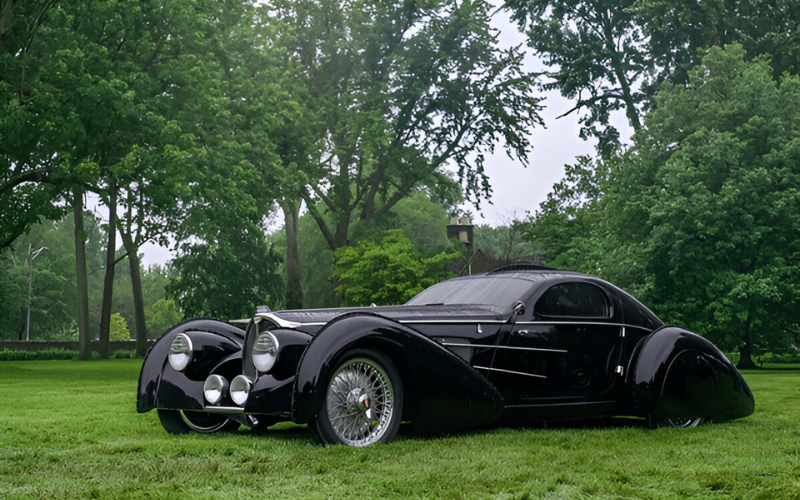Introduction
The Bugatti Atlantic is one of the rarest and most beautiful cars ever built. Created in the 1930s, it blends art, innovation, and performance in a way that few automobiles have ever matched. With its flowing lines, lightweight construction, and limited production, the Atlantic has become more than just a car — it’s a cultural icon and a piece of history.
Origins of the Bugatti Atlantic
Background of Bugatti in the 1930s
During the 1930s, Bugatti was already well known for building elegant and highly advanced cars that stood apart from the competition. Ettore Bugatti, the company’s founder, had built a reputation for combining engineering precision with artistic design. At this time, the automotive world was rapidly evolving, with manufacturers experimenting with aerodynamics, lightweight materials, and more daring designs. Against this backdrop, Bugatti sought to create something extraordinary — a car that would not only showcase technical brilliance but also stand as a true work of art.
The Vision Behind the Creation of the Atlantic
The Bugatti Atlantic was born from the vision of Jean Bugatti, Ettore’s son, who wanted to push the boundaries of automotive design. Inspired by aviation and the futuristic use of lightweight alloys, Jean created a car unlike anything the world had seen before. His goal was not just to design a vehicle for speed but to produce an object of beauty and innovation. The Atlantic’s signature look — with its long, flowing lines and dramatic riveted seam — reflected a bold experiment in both aesthetics and engineering, setting the stage for its legendary status.
Striking Design and Aesthetic Appeal
Unique Body Styling and Aerodynamic Curves
The Bugatti Atlantic is instantly recognizable thanks to its dramatic proportions and flowing silhouette. Its long bonnet, teardrop-shaped cabin, and sweeping fenders gave it an elegance that set it apart from other cars of its era. Unlike many vehicles of the 1930s, which often looked boxy and upright, the Atlantic embraced a streamlined form that hinted at motion even when standing still. The central riveted seam, running from the front grille to the rear, became one of its most defining visual elements — a detail that not only solved engineering challenges but also gave the car a bold and distinctive character.
Influence of Aviation on Its Design
Jean Bugatti’s inspiration for the Atlantic came largely from the world of aviation, which was advancing rapidly at the time. Aircraft design emphasized lightness, aerodynamic efficiency, and strength, ideas that were still new in the car industry. The Atlantic carried this influence with its smooth, flowing bodywork and use of lightweight materials such as aluminum alloys. Even the riveted seam echoed techniques seen on airplanes of the era. This blend of automotive craftsmanship and aviation-inspired innovation gave the Atlantic its futuristic appearance — one that still feels modern nearly a century later.
Engineering and Performance Innovations
Technical Specifications That Set It Apart
Beneath its striking design, the Bugatti Atlantic carried engineering features that were ahead of its time. Powered by a 3.3-liter straight-eight engine, it delivered impressive performance for the 1930s, capable of reaching speeds around 120 mph (193 km/h) — a remarkable figure in that era. The engine was paired with a lightweight body, built from advanced materials such as aluminum alloys, which reduced weight without compromising strength. This focus on both power and efficiency gave the Atlantic an edge over many of its contemporaries, showcasing Bugatti’s reputation for precision engineering.
Driving Dynamics and Innovations of Its Time
The Atlantic wasn’t just about speed; it also offered a refined driving experience. Its low-slung chassis improved handling, while its suspension design allowed for better stability on uneven roads compared to other luxury cars of the 1930s. Jean Bugatti’s emphasis on aerodynamics also contributed to smoother performance, reducing drag and enhancing both efficiency and comfort. These elements made the Atlantic not only a beautiful machine to look at but also a forward-thinking automobile that blended luxury with technical innovation.
Rarity and Collectability
How Many Bugatti Atlantics Were Made
The Bugatti Atlantic is considered one of the rarest cars in the world. Only four examples were originally built between 1936 and 1938, making it an exceptionally limited production even by the standards of the time. Each car was slightly different, with unique details tailored to its first owner, further adding to their exclusivity. Because of this, the Atlantic quickly became a symbol of rarity and prestige in the automotive world.
Stories of Surviving Models and Their Value Today
Of the four Atlantics produced, only a handful have survived, with some preserved in private collections and others displayed in museums. Each surviving model carries with it a fascinating history, often passing through the hands of notable collectors and enthusiasts. Due to their scarcity and unmatched design, these cars have commanded record-breaking prices at auctions — in some cases reaching well over $30 million. Today, the Atlantic is not just a classic automobile but a cultural treasure, valued as much for its artistry and legacy as for its engineering.
Cultural and Historical Impact
Influence on Future Car Design
The Bugatti Atlantic’s groundbreaking style left a lasting mark on the automotive world. Its long, flowing curves and aerodynamic profile influenced generations of car designers who saw it as proof that a vehicle could be both functional and artistic. Many modern supercars still echo elements of the Atlantic’s silhouette, from elongated front ends to sculpted fenders. Designers often cite it as an early example of the harmony between engineering precision and aesthetic beauty, setting a standard that continues to inspire innovation in luxury and performance cars.
Presence in Museums and Major Auctions
Because of its rarity and cultural significance, the Bugatti Atlantic is showcased as a masterpiece in the world’s most prestigious collections. Some examples are housed in renowned museums, where they are treated as much like works of art as historic vehicles. When Atlantics have appeared at major auctions, they have attracted global attention, often setting records for automotive sales. These moments reinforce the car’s legendary reputation, reminding enthusiasts and historians alike of its unmatched importance in automotive history.
The Bugatti Atlantic’s Enduring Legacy
Why It Remains One of the Most Celebrated Classics
The Bugatti Atlantic holds a special place in automotive history because it represents the perfect blend of art, engineering, and exclusivity. Few cars manage to capture the imagination of both enthusiasts and casual admirers in the same way. Its combination of rarity, innovative design, and historical importance has ensured its status as one of the most celebrated classics of all time. For many, the Atlantic is not simply a car but a symbol of creativity and craftsmanship at its highest level.
The Modern Fascination With This Automotive Masterpiece
Even today, nearly a century after its creation, the Bugatti Atlantic continues to fascinate collectors, designers, and car lovers around the world. Modern Bugatti models often pay tribute to its design language, and automotive museums treat it as a priceless treasure. The mystique surrounding the few surviving examples, coupled with their record-breaking values at auctions, keeps the Atlantic in constant discussion among enthusiasts. It remains a timeless reminder of what happens when imagination and innovation come together to create something truly extraordinary.
Conclusion
The Bugatti Atlantic is more than just a rare vintage automobile — it is a lasting symbol of creativity, innovation, and craftsmanship. From its groundbreaking design in the 1930s to its present-day status as one of the most valuable and admired classics, the Atlantic continues to capture the imagination of car lovers and historians alike. Its influence can be seen in modern automotive design, and its enduring mystique ensures that it will always hold a unique place in cultural and automotive history.
FAQ
Q1: How many Bugatti Atlantics still exist today?
Out of the four Atlantics originally built in the 1930s, only a few are known to survive. Some are preserved in private collections, while others are displayed in museums.
Q2: Why is the Bugatti Atlantic considered so valuable?
Its extreme rarity, unique design, and cultural importance make the Atlantic one of the most valuable cars in the world. Auction prices have reached tens of millions of dollars, reflecting both its historical significance and desirability among collectors.
Q3: What inspired the unique design of the Bugatti Atlantic?
Jean Bugatti drew inspiration from aviation and advanced materials of his time. The car’s flowing curves, lightweight body, and riveted spine were influenced by aircraft design and new construction methods.
Q4: Where can enthusiasts see a Bugatti Atlantic in person?
Surviving Atlantics can occasionally be seen in prestigious museums and at select automotive exhibitions. They also appear at high-profile auctions, where they often attract worldwide attention.

